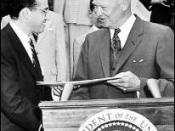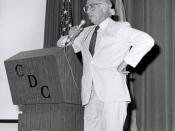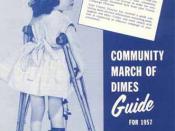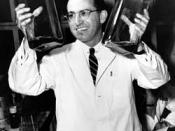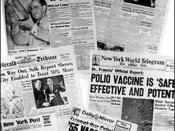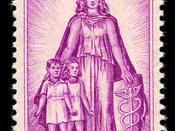History I Honors22 February 2009In America in the 1950s, summer was a time of despair and concern for most parents; this was the time when children by the thousands became infected with the crippling disease polio. Fortunately this fear was lifted forever when it was announced that Dr. Jonas Salk had developed a vaccine against towards this disease. Salk became world-famous overnight, but his discovery was the result of many years of painstaking research.
Jonas Salk was born in New York City. His parents were immigrants who lacked a formal education, but were determined to see their children succeed and encouraged them to study hard. Jonas Salk was the first member of his family to go to college; he entered the City College of New York intending to study law, but soon became intrigued by medical science. While in college he met his future wife, Donna Lindsay, whom he married on June 9, 1939.
They had three children: Peter, Darrell, and Jonathan. In 1968, they divorced, and in 1970 Salk married Françoise Gilot, the former mistress of Pablo Picasso.
While attending medical school at New York University, Salk was invited to spend a year researching influenza. The virus that causes flu had only recently been discovered and Salk waseager to learn if the virus could be deprived of its ability to infect, but still give immunity to the illness. Salk succeeded in this attempt, which became the basis of his later work on polio.
After completing medical school and his internship, Salk returned to the study of influenza, the flu virus. World War II had begun, and public health experts feared a replay of the flu epidemic that had killed millions in the wake of World War I. The development of vaccines controlled the spread of flu after the war and the epidemic of 1919 did not recur. In 1947, Salk accepted an appointment to the University Of Pittsburgh Medical School. While working there, with the National Foundation for Infantile Paralysis, Salk saw an opportunity to develop a vaccine against polio; he devoted himself to this work for the next eight years.
Polio is a highly infectious disease caused by a virus. It invades the nervous system and can cause total paralysis in a matter of hours. This incurable disease can strike at any age but mainly affects children under 5 years of age. One in 200 infections led to irreversible paralysis (usually in the legs). Among those paralyzed, 5% to 10% would die when their breathing muscles become immobilized.
The virus enters the body through contaminated food, dirty fingers or water tainted with sewage. The virus attaches to receptors on the intestinal walls; this is where it gets into the bloodstream. It then invades the CNS (central nervous system) spreading along nerve fibers. As it multiplies the virus destroys nerve cells, motor neurons, which are the neurons needed to activate muscles. These nerve cells cannot be regenerated and therefore, the affected muscles no longer function. In the most severe cases, the polio virus attacks the motor neurons of the brain stem, reducing breathing capacity and causing difficulty in swallowing and speaking. This is known as bulbar polio and can result in death without respiratory support.
The fight against polio didnÃÂt actually begin until 1938 when the National Foundation for Infantile Paralysis was discovered. Basil O'Connor, the former law partner of President Franklin D. Roosevelt, America's most distinguished polio victim, began it. Also that same year, the first March of Dimes fundraising program was set up, radio networks offered free 30-second slots for promotion. Audience members were asked to send in a dime to the White House. They received 2,680,000 letters within days a few days. As the fear of polio increased each year, funds to fight it increased from $1.8 million to $67 million by 1955. Research continued during those years, but, OÃÂNeill writes, "Everything scientists believed about polio at first was wrong, leading them down many blind alleys. Furthermore, most researchers were experimenting with highly dangerous live vaccines. In one test six children were killed and three left crippled."Although there is still not a cure for polio to this day, it has been brought under control by immunization. In 1955 Salk's years of research paid off, the human trials of the polio vaccine effectively protected the subject from the polio virus. When news of the discovery was made public on April 12, 1955; Salk was hailed as a miracle worker. He further endeared himself to the public by refusing to patent the vaccine. He had no desire to profit personally from the discovery, but merely wished to see the vaccine disseminated as widely as possible.
Salk's vaccine was composed of "killed" polio virus, which retained the ability to immunize without running the risk of infecting the patient. A few years later, a vaccine madefrom live polio virus was developed, which could be administered orally, while Salk's vaccine required injection. Also there was some evidence that the "killed" vaccine failed to completely immunize the patient.
In the U.S., public health authorities elected to distribute the "live" oral vaccine instead of Salk's. Unfortunately the preparation of the live virus infected some patients with the disease, rather than immunizing them. Since the introduction of the original vaccine, the few new cases of polio reported in the United States were probably caused by the "live" vaccine which was intended to prevent them. In countries where Jonas Salk's vaccine still has remained in use, the disease has been nearly eradicated.
Beginning in the early 1980ÃÂs, Salk also engaged in research to develop a vaccine for another, more recent plague, AIDS. To further this research, he co-founded The Immune Response Corporation with Kevin Kimberlin, to search for a vaccine, and they also patented Remune, an immune-based therapy. It has not yet been evaluated by the U.S Food and Drug Administration (FDA) for use by people living with HIV. Unfortunately Salk died at age 81 due to heart failure; before a successful vaccine was found, and although many advances were made in treating AIDS, ÃÂThe world still waited for the miracle vaccine the conqueror of polio had sought,ÃÂ wrote historian Alan Axelrod.
Fortunately before his death, Salk founded the Jonas Salk Institute for Biological Studies in 1963; it was an innovative center for medical and scientific research. Jonas Salk also began to publish books, some even written with one or more of his sons, who are also medicalscientists. Salk's published books include Man Unfolding, The Survival of the Wisest, World Population and Human Values: A New Reality, and Anatomy of Reality.
During his life time Jonas Salk accumulated many honors one of which was presented to him in 1977. It was the Presidential Medal of Freedom and was given to him by President Jimmy Carter, and with the following statement accompanying the medal:ÃÂBecause of Doctor Jonas E. Salk, our country is free from the cruel epidemics of poliomyelitis that once struck almost yearly. Because of his tireless work, untold hundreds of thousands who might have been crippled are sound in body today. These are Doctor SalkÃÂs true honors and there is no way to add to them. This Medal of Freedom can only express our gratitude, and our deepest thanks.ÃÂThanks to Jonas Salk in 2008 researchers found only 4 countries in the world which remain polio-endemic, this is down from more than 125 countries in 1988. The remaining countries are Afghanistan, India, Nigeria and Pakistan. Since 1988 the number of polio cases has fallen by over 99%.
Works CitedI.www.faqs.org, http://www.faqs.org/health/bios/14/Jonas-Salk.htmlII.www.time.com, http://www.time.com/time/time100/scientist/profile/salk03.htmlIII.www.kidshealth.org, http://kidshealth.org/parent/infections/bacterial_viral/polio.html
